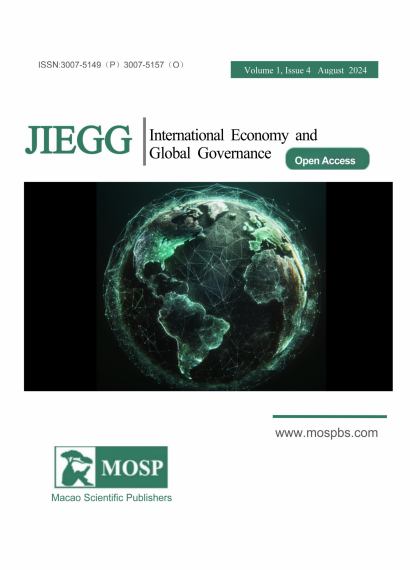-
Christopher, M.J., & Peck, H. (2004). Building the Resilient Supply Chain. The International Journal of Logistics Management, 15, 1-14
-
Tapscott, D. (1996). The digital economy: promise and peril in the age of networked intelligence. McGraw-Hill.
-
Gnimpieba, D.R., Nait-Sidi-Moha, A., Durandb, D., & Fortina, J. (2015). Using Internet of Things Technologies for a Collaborative Supply Chain: Application to Tracking of Pallets and Containers. FNC/MobiSPC.
-
Yang, R. (2021). Major issues and countermeasures in promoting the new development of digital economy. National Governance, 18, 17-20.
-
Barney, J.B., Ketchen, D.J., & Wright, M. (2011). The Future of Resource-Based Theory. Journal of Management, 37, 1299 - 1315.
-
Teece, D.J., Pisano, G.P., & Shuen, A. (1997). DYNAMIC CAPABILITIES AND STRATEGIC MANAGEMENT. Strategic Management Journal, 18, 509-533.
-
Gereffi, G., & Korzeniewicz, M. (1994). Commodity Chains and Global Capitalism.
-
Oliver, R.K., & Webber, M.D. (1982). Supply-chain management: logistics catches up with strategy.
-
Coase, R.H. (1937). The Nature of the Firm. Economica, 4, 386-405.
-
Williamson, O.E. (1979). Transaction-Cost Economics: The Governance of Contractual Relations. The Journal of Law and Economics, 22, 233 - 261.
-
Wang, Z., Chen, Y., & Zhang, M. (2021). Measuring global digital economy development: Characteristic facts based on the TIMG index. Chinese Review of Financial Studies, 13(6), 40-56, 118-119.
-
Kurnia, S., Karnali, R.J., & Rahim, M.M. (2015). A qualitative study of business-to-business electronic commerce adoption within the Indonesian grocery industry: A multi-theory perspective. Inf. Manag., 52, 518-536.
-
Yang, R. F. (2021). Major issues and countermeasures for advancing the new development of the digital economy. Governance, (18), 17-20. doi: 10.16619/j.cnki.cn10-1264/d.2021.18.004.
-
Tokito, S., Hanaka, T., & Nagashima, F. (2022). Carbon Footprint Analysis Based on the Structural Position in the Global Supply-Chain Networks. SSRN Electronic Journal.
-
Sheng, Z. H., Wang, H. Y., & Hu, Z. H. (2022). Supply chain resilience: Adapting to complexity—Based on the perspective of complex system management. Chinese Journal of Management Science, (11), 1-7. doi: 10.16381/j.cnki.issn1003-207x.2022.11.001.
-
Fan, X. M., & Lu, M. Y. (2020). Factors influencing supply chain resilience of automotive enterprises under the COVID-19 pandemic and evaluation. Industrial Technology & Economy, 39(10), 8.
-
Datta, P.P. (2017). Supply network resilience: a systematic literature review and future research. The International Journal of Logistics Management, 28, 1387-1424.
-
Jain, V., Kumar, S., Soni, U., & Chandra, C. (2017). Supply chain resilience: model development and empirical analysis. International Journal of Production Research, 55, 6779 - 6800.
-
Ishfaq, R. (2012). Resilience through flexibility in transportation operations. International Journal of Logistics Research and Applications, 15, 215 - 229.
-
Kristianto, Y., Gunasekaran, A., & Helo, P.T. (2017). Building the “Triple R” in global manufacturing. International Journal of Production Economics, 183, 607-619.
-
Wieland, A. (2021). Dancing the Supply Chain: Toward Transformative Supply Chain Management. The Journal of Supply Chain Management, 1(57), 58-73.
-
Soni, U., Jain, V., & Kumar, S. (2014). Measuring supply chain resilience using a deterministic modeling approach. Comput. Ind. Eng., 74, 11-25.
-
Schallmo, D., Williams, C.A., & Boardman, L. (2017). Digital Transformation of Business Models — Best Practice, Enablers, and Roadmap. Digital Disruptive Innovation.
-
Olorunniwo, F., & Li, X. (2010). Information sharing and collaboration practices in reverse logistics. Supply Chain Management, 15, 454-462.
-
Ferreira, J.J., Fernandes, C.I., & Ferreira, F.A. (2019). To be or not to be digital, that is the question: Firm innovation and performance. Journal of Business Research.
-
Wernerfelt, B. (1984). A Resource-Based View of the Firm. Southern Medical Journal, 5, 171-180.
-
Barney, J.B., Ketchen, D.J., & Wright, M. (2011). The Future of Resource-Based Theory. Journal of Management, 37, 1299 - 1315.
-
Blackhurst, J., Dunn, K.S., & Craighead, C.W. (2011). An Empirically Derived Framework of Global Supply Resiliency. Journal of Business Logistics, 32, 374-391.
-
Brandon-Jones, E., Squire, B., Autry, C.W., & Petersen, K.J. (2014). A contingent resource-based perspective of supply chain resilience and robustness. Journal of Supply Chain Management, 50, 55-73.
-
Lee, S.M., & Rha, J.S. (2016). Ambidextrous supply chain as a dynamic capability: building a resilient supply chain. Management Decision, 54, 2-23.
-
Oliver, R.K., & Webber, M.D. (1982). Supply-chain management: logistics catches up with strategy.
-
Chowdhury, M.H., & Quaddus, M. (2017). Supply chain resilience: Conceptualization and scale development using dynamic capability theory. International Journal of Production Economics, 188, 185-204.
-
Gereffi, G., & Korzeniewicz, M. (1994). Commodity Chains and Global Capitalism.
-
Mentzer, J.T., DeWitt, W., Keebler, J.S., Min, S.H., Nix, N.W., Smith, C.D., & Zacharia, Z.G. (2001). DEFINING SUPPLY CHAIN MANAGEMENT. Journal of Business Logistics, 22, 1-25.
-
Coase, R.H. (1937). The Nature of the Firm. Economica, 4, 386-405.
-
Williamson, O.E. (1979). Transaction-Cost Economics: The Governance of Contractual Relations. The Journal of Law and Economics, 22, 233 - 261.
-
Bode, C., & Wagner, S.M. (2015). Structural drivers of upstream supply chain complexity and the frequency of supply chain disruptions. Journal of Operations Management, 36, 215-228.
-
Lee, H. (2004). The triple-A supply chain. Harvard business review, 82 10, 102-12, 157.
-
Kurnia, S., Karnali, R.J., & Rahim, M.M. (2015). A qualitative study of business-to-business electronic commerce adoption within the Indonesian grocery industry: A multi-theory perspective. Inf. Manag., 52, 518-536.
-
Wang, Y., Han, J.H., & Beynon-Davies, P. (2019). Understanding blockchain technology for future supply chains: a systematic literature review and research agenda. Supply Chain Management: An International Journal.
-
Chen, X. D., & Yang, X. X. (2022). Does digital transformation enhance the autonomy and controllability of industrial chains? Economic Management, (08), 23-39. doi: 10.19616/j.cnki.bmj.2022.08.002.
-
Sun, H. P., & Wei, W. (2020). Resilience and risk of China's embedding in the global value chain under the COVID-19 pandemic. Review of Economic Research, (06), 91-98. doi: 10.16110/j.cnki.issn2095-3151.2020.06.012.
-
Wang, Z. M. (2022). The impact of RCEP on Asian supply chains: A discussion of the "China Plus One" strategy. Asia-pacific Economic Review, (03), 19-26. doi: 10.16407/j.cnki.1000-6052.2022.03.002.
-
Ma, D., & Tang, J. Q. (2023). Estimation and analysis of the added value of the global digital value chain. Statistical Research, (06), 3-19. doi: 10.19343/j.cnki.11-1302/c.2023.06.001.
-
Yang, R. F., & Zheng, Y. Y. (2023). Research on the impact of digital economy development on the evolution and resilience of global value chain division of labor. The Journal of Quantitative & Technical Economics, (08), 69-89. doi: 10.13653/j.cnki.jqte.20230706.001.
-
Tao, F., Wang, X. R., Xu, Y., & Zhu, P. (2023). Digital transformation, industrial chain and supply chain resilience, and enterprise productivity. China Industrial Economics, (05), 118-136. doi: 10.19581/j.cnki.ciejournal.2023.05.012.
-
Du, Y., & Lou, J. (2022). The impact of digital transformation on enterprise upgrading and its spillover effects. Journal of Zhongnan University of Economics and Law, (05), 119-133. doi: 10.19639/j.cnki.issn1003-5230.2022.0062.
-
Qi, J. Y., & Ren, Y. D. (2021). The impact of digital economy penetration on global value chain division of labor: A cross-country empirical study based on industry heterogeneity. Journal of International Trade, (09), 105-121. doi: 10.13510/j.cnki.jit.2021.09.007.
-
Shi, B. Z., & Li, J. T. (2020). Does the internet promote division of labor? Evidence from Chinese manufacturing enterprises. Management World, (04), 130-149. doi: 10.19744/j.cnki.11-1235/f.2020.0058.
-
Zhang, Y., Fan, S. M., & Zhang, H. (2024). Research on the optimization path of China's industrial chain modernization. Journal of Industrial Technological Economics, (03), 14-22.
-
Wu, W. H. (2019). The situation and countermeasures of China's participation in the formulation of global digital trade rules. Intertrade, (06), 55-60. doi: 10.14114/j.cnki.itrade.20190730.011.
-
Qi, J. Y., & Ren, Y. D. (2021). The impact of digital economy penetration on global value chain division of labor: A cross-country empirical study based on industry heterogeneity. Journal of International Trade, (09), 105-121. doi: 10.13510/j.cnki.jit.2021.09.007.

